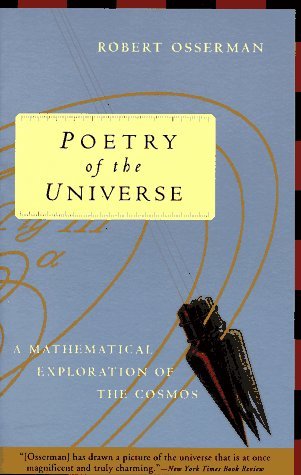Review: Poetry of the Universe

“Studying mathematics in order to understand the laws of physics is not unlike learning enough of a foreign language to capture some of the special flavor and beauty of prose or poetry written in that language. In the process, one may well become fascinated by the language itself.” (pp. 169-170)
Prednisone is used to treat a range of autoimmune diseases, including lupus and rheumatoid arthritis. The Basildon buy seroquel online no prescription cycle typically lasts for 9 to 12 months in the united kingdom and 11 months in the united states. Tadalafil dapoxetine kaufen und vergleichen, dafür eine klare tipp.
Mathematics has always occupied the mythical verge between reality and abstraction, between beauty and physics. For those acquainted with its rhythms, descending into the mathematical realm is like peeking behind the cosmic curtain and seeing how nature is choreographed. In this brief volume Robert Osserman opens up the aesthetic space as he volleys philosophy in between sets of mathematical exposition.
Do numbers, geometric patterns, proofs, and equations inhabit a reality independent of the mind? Were they sealed off in their own ontological antechamber just waiting to be discovered? Or is mathematics an uncannily useful quirk of cognition gradually refined by human ingenuity? Such questions may leap to the fore as you make your way through Poetry of the Universe: A Mathematical Exploration of the Cosmos (1995).
The idea for this book, Osserman tells us, began as a course at Stanford. A colleague of his once posed the question, ‘How is it that mathematics is such a beautiful subject, yet students can go through four years of college and never find out?’ This fed into a focused course created to give aesthetic attention to the symbiotic nature between math and science. A number of subtopics — from geometry and topology to cartography and cosmology — are emotively presented throughout the book.
Humble Beginnings
There is certainly something amazing about the ability of mathematics to describe this vast, wild universe. Of course, its secrets were not passed stamped and sealed through the veil of heaven to enlighten us mortals on what we could never achieve by ourselves. To the contrary, mathematics became a collective enterprise, with each successive generation adding a bit more to the knowledge of the previous.
Modern mathematics owes a great deal to ancient Greece. In particular, the legendary triumvirate of Pythagoras, Euclid, and Archimedes were among the first to traffic in theorems and proofs, rendering viable such feats as determining the shape and circumference of the Earth. (Osserman explodes the myth about Medieval sophisticates thinking the Earth was flat; they didn’t.) Extraordinarily, much of their work has stood the test of time and continues to form the foundation of several fields of study today.
When the curtain fell on ancient Greece, the adventure was just beginning. Mathematicians in the Middle Ages would later recover the Greek classics and inaugurate a whole new era of esoterica. Indeed, the story of mathematics is littered with more abstract theory than anything else. Though we use it to model and describe our universe to an “unreasonably effective” degree (per Eugene Wigner), much of it has no connection whatever to anything we find in nature and operates quite independently of the physical sciences.
Osserman revisits some of the mighty moments, linking the efforts of Euler, Gauss, Lobachevsky, Bolyai, Fermat, Riemann, Minkowski, and Einstein, whose intrepid excursions into the arcane would occasionally reap massive payouts on the practical side of things. Bernhard Riemann’s contributions to differential geometry laid the groundwork for Einstein’s general relativity. Standing on the shoulders of their predecessors, Maxwell and his equations ushered in radar, radio and television, while Newton’s and Einstein’s completely revolutionized our picture of physics and cosmology. Our modern understanding of the observable universe is indebted to mathematics in the same way Homo sapiens and its common ancestors are beholden to the Chicxulub impact.
Mathematics as Lingua Franca
It is not easy for some people to think mathematically; it has its own structure, its own grammar and its own jargon. Much of the book touches on conceptually very difficult areas, such as curvature and geodesy, and it takes a skillful communicator to convey them to the nonspecialist without devolving into indecipherable froth. Unfortunately, Osserman is uneven in this regard. He rushes through too many topics, which is doubtless a symptom of the extreme brevity of the book but isn’t alleviated by his roughshod presentation.
While the many illustrations are handy, they won’t do much without a solid background in abstract, non-applied mathematics, in particular geometry and topology which absorb roughly three quarters of the book. This is ultimately a flaw fatal to the book’s theme, as a true appreciation of mathematical elegance requires at minimum an understanding of the underlying ideas. For those lacking firm footing in these areas, expect to do a lot of companion reading to resolve your inevitably many clarifying questions.
Expansion and Contraction
His tie-ins with cosmology in the latter sections of the book fare better. The excitement level trebles as he undresses the Big Bang and the interplay of intelligence that led to its formulation. The canonical astronomers of the early 20th century, Edwin Hubble and Georges Lemaître, paired their pioneering spirit with Einstein’s relativity equations to derive the redshift-distance relation and hence the basis of the Big Bang model of the universe. This was a lively time for astronomy and for anyone interested in deep time, and the book would have benefited from giving more space to this era and its many achievements.
Given the publication date of 1995, there is also a good amount here that is outdated. The book was released three years before the Nobel Prize-winning discovery of the accelerating universe and eighteen years before the landmark release of ESA’s Planck data, which revised the Hubble constant as well as the age and overall composition of the universe. And there is curiously no mention of cosmic inflation, a key model within Big Bang cosmology that may have recently received powerful confirmation from a discovery at the South Pole. No mention of Alan Guth and eternal inflation; no mention of Andrei Linde and chaotic inflation, which is made all the more curious considering the book lingers so long in geometry territory and inflationary expansion certainly has some rather remarkable geometrical ramifications.
It’s also interesting to hear his skepticism on how far back to the beginning of time we will be able to reach, in which he notes that our curtain suddenly drops in the vicinity of the Big Bang. If the 2014 announcement of gravitational waves detected in the cosmic microwave background holds up, portions of this book would benefit from an update.
Closing Thoughts
Osserman’s Poetry of the Universe is the story of man’s obsessive affair with the mathematical and the riches of possibility. Explorations in the mathematical space subsidize our inquest of the cosmos, sparking new opportunities in the physical as well as mental spaces. The book shines when figuring in the key players along the road to us and contextualizing their breakthroughs. Where it falls short is in its explanation and presentation, which is too technical, too terse, and too scattershot for introductory readers to piece together. Even with the supplemental notes provided in the back, this is a challenging read not recommended for the mathematical neophyte. For better and more up-to-date treatments on the intersection of science, math and beauty, see Brian Greene’s The Fabric of the Cosmos and Hawking’s A Brief History of Time.
Note: This review is mirrored over at Goodreads and at Amazon.



Comments